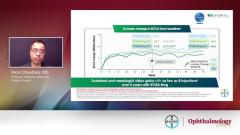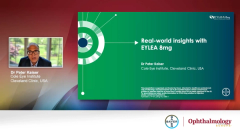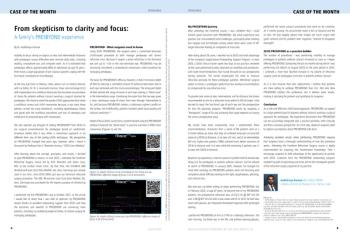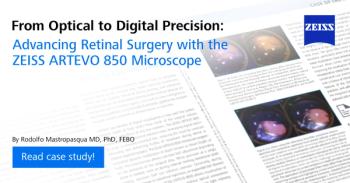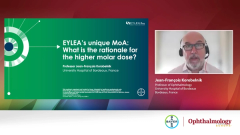
Real World insights with EYLEA 8mg
Peter Kaiser, MD: Welcome and thank you for joining us for this third video in the series on EYLEA 8mg. Today we will discuss real-world insights with EYLEA 8mg. My name is Dr. Peter Kaiser. I’m from the Cole Eye Institute at Cleveland Clinic in the United States.
Before we begin, I’d like to share my financial disclosures. Of note, I have been compensated by Bayer for my participation in this video.
To recap the earlier videos in the series, we have explored EYLEA’s unique mechanism of action and discussed key insights from the PULSAR and PHOTON trials. Now, let’s move on to discuss the real-world impact of EYLEA 8mg for patients with neovascular AMD and diabetic macular edema.
So, let’s start with this important question—how can longer-acting agents address unmet needs in retinal care? Let’s explore this through the lens of real-world data.
EYLEA 8mg delivers a four-fold higher molar dose compared to EYLEA 2mg, and it's estimated to remain in the eye for approximately 6 weeks longer. Why is this significant? Well, with its 4-fold higher molar dose compared with the EYLEA 2mg, EYLEA 8mg aims to achieve sustained disease control for all eligible patient groups, potentially addressing key unmet needs in retinal care.
To highlight this, let’s look at this illustrative model. With current treatment options, a significant number of patients require anti-VEGF injections every 6 to 12 weeks, and this is shown by the first peak on the left side of the slide. Other patients, however, do very very well, and are able to extend their treatment intervals to around 4 months, and that’s shown by the second peak on the right.
With the introduction of longer-acting agents, we expect a shift in this distribution, with the majority of patients achieving treatment intervals of more than four months. This advancement has the potential to significantly reduce treatment burden for patients. But we must not forget the second part, which are those hard-to-treat patients on the left side of this curve, because those patients will also have an increase in treatment durability. Maybe not out to 4 or 5 months, but even if they can gain 2 to 3 weeks, this is a reduction in treatment burden, and a significant advancement.
Compared to the 2 mg formulation, EYLEA 8 mg has the potential to provide improved disease control, and this is achieved through faster and longer-lasting drying, as well as sustained, meaningful vision gains with as few as two injections per year. Finally, EYLEA 8mg maintains a long-term safety profile that is comparable to EYLEA 2mg, and this provides a lot of reassurance for both clinicians as well as patients.
Now that we have discussed how EYLEA 8mg can improve our management of retinal diseases, let’s shift gears. I’d like to share with you some of my own patient cases that highlight the impact of EYLEA 8mg.
Let's start with a patient with age-related macular degeneration.
Their visual acuity is pretty good, and they have both sub-RPE and subretinal fluid. The patient's insurance required us to use bevacizumab off-label, and we did this for 3 injections with minimal improvement in retinal fluid. And at that point we switched the patient to EYLEA 2mg.
With this treatment the fluid relatively remained the same. So, after 4 injections of EYLEA 2mg, the visual acuity was the same, and the fluid was essentially the same. So, we elected at this point to switch to faricimab at the same treatment interval of 6 weeks, and when they returned, they actually had increased retinal fluid as well as subretinal hyperreflective material or SHRM (Subretinal Hyperreflective Material), indicating an increase in activity. Now the patient didn't notice this because the visual acuity remained the same, and we elected to try to treat them again with faricimab, with a similar result, in that we didn't see any anatomic improvement. In fact, it appeared worse, but the visual acuity remained the same. We then elected to change the patient to EYLEA 8mg at the same treatment interval, and when they returned the fluid had improved, and the visual acuity had improved, and after another 6-week interval, additional improvements in both retinal fluid was seen, and the visual acuity remained at 20/25.
Here's another patient with age-related macular degeneration, a fibrovascular pigment epithelial detachment and subretinal fluid. In contrast to the first case, this patient was started on EYLEA 2mg, and after 3 injections we really couldn't extend the interval much beyond 4 to 6 weeks. So again, we decided to switch this patient to faricimab at the same six-week interval, and the fluid was essentially the same with the visual acuity dropping just slightly.
And so, we reduced the interval on faricimab to a 4-week interval, and when the patient returned, not only had the fluid gotten worse, the visual acuity had also worsened. And so, because of that, we switched the patient to EYELEA 8mg and brought them back 4 weeks later, at which time their visual acuity had improved and their OCT had also improved.
I'd like to now discuss the real-world durability of EYLEA 8mg with another case from my practice.
Here's another case of a patient with neovascular, age-related macular degeneration and a large pigment epithelial detachment. We elected to treat this patient with EYLEA 2mg from the beginning due to findings in the past, where pigment epithelial detachments respond very well. And, as you can see, after just one injection, the pigment epithelial detachment had indeed improved, and the visual acuity had also improved. Now, in the absence of intraretinal fluid, we elected to extend the interval to 6 weeks, and when they returned, they did have an increase in fluid and so we just kept the same interval, and they did well the next return. So, we increased the interval to 8 weeks and then at that point we decided to try to go even further, and we switched the patient to EYLEA 8mg.
After we switched, they returned 8 weeks later with an improvement in their fibrovascular pigment epithelial detachment, and no intraretinal fluid, so we extended the interval to 12 weeks. They did great. We extended the interval to 16 weeks, they did great. We extended the interval to 20 weeks. The patient continues to do well with visual acuity of 20/25, no intrarenal fluid, and a reduction in that fibrovascular pigment epithelial detachment. So, at this next visit I would elect to see the patient at a 24-week interval, and hopefully, if they do well, keep them at that interval.
So, another question you need to consider as opposed to these switch cases I just showed you would be, would you use EYLEA 8mg in a treatment-naive patient? And indeed, I do do this also.
Here's a patient with bilateral, neovascular, age-related macular degeneration, with loss of vision in both eyes to 20/100 in the right eye, 20/60 in the left and a lot of fluid. So, this is a patient who has already lost vision and so we want to try and treat this patient as aggressively as we can. And so, we elected to treat this patient with EYLEA 8mg in both eyes at that first visit. And when they returned 4 weeks later, thankfully, both eyes had gained visual acuity and both eyes, the fluid had done better with no intraretinal fluid or subretinal fluid, and so we decided already to extend the interval to 6 weeks. And at that interval they returned again with even more improvement in visual acuity as well as their OCT. And at the next visit we would have seen them at 8 weeks. So, this really nicely shows how a patient, who was already starting to really go down at baseline responded beautifully in both eyes to EYLEA 8mg.
So, as we conclude, I'd like to share some advice to retina specialists who are just starting to prescribe EYLEA 8mg. As that graph showed, for switching patients, there's really two use scenarios. On the left of that graph were those patients who were requiring very frequent injections, maybe 4, 6, even 8-week intervals, and we simply couldn't extend those intervals. And if we could extend those patients even 2 to 4 weeks longer, we're reducing the treatment burden. The second use scenario I also illustrated, which are those patients who are actually doing very well on, for instance, EYLEA 2 mg. They may be at 16-week intervals. But EYLEA 8mg allows you to extend the intervals up to 24 weeks. So, 2 injections a year, and that would be an amazing interval for a patient to continue to maintain those visual acuity gains. Thank you for joining us in this video. And hopefully, this will help you in prescribing EYLEA 8mg in your patients.
Newsletter
Get the essential updates shaping the future of pharma manufacturing and compliance—subscribe today to Pharmaceutical Technology and never miss a breakthrough.

